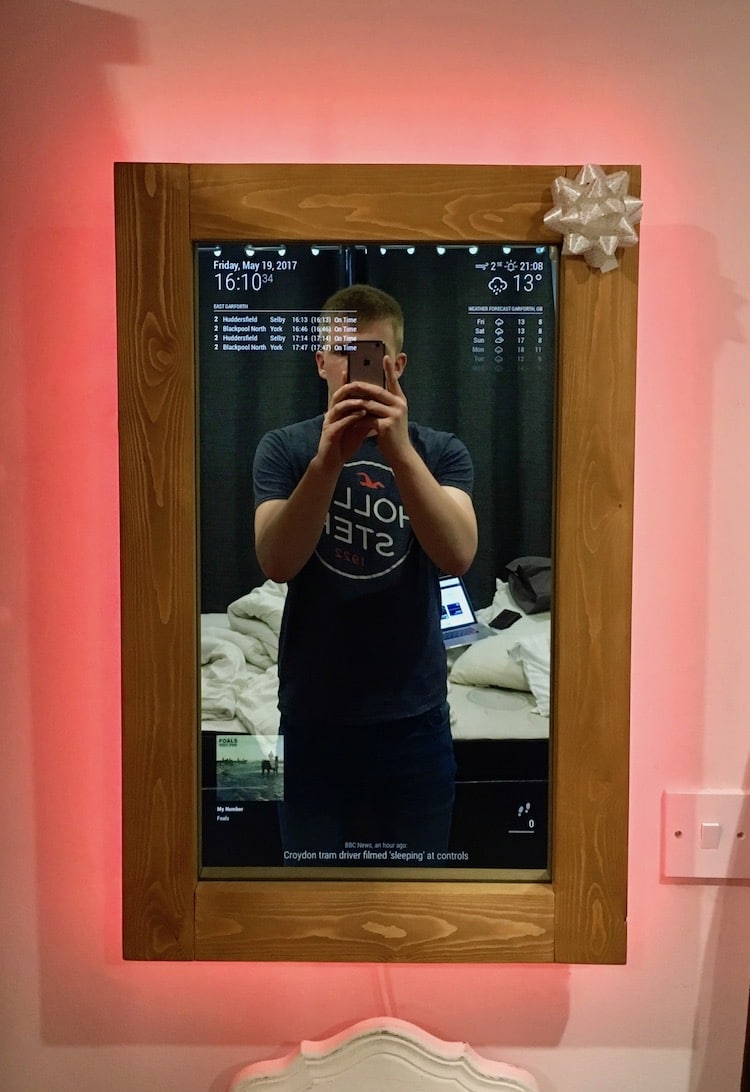
- #Diy magic mirror tutorial how to#
- #Diy magic mirror tutorial windows 10#
- #Diy magic mirror tutorial software#
- #Diy magic mirror tutorial windows#
This information is relayed back to your Raspberry Pi corresponding to your display.īuilding Mirror Frame And Assembly of partsĪ wooden frame was built In order to encase the 32 inch Monitor. Similar to an optical mouse USB peripheral, based on where you touch the frame a beam interruption occurs and the IR sensor is able to co-ordinate where you’ve touched. Typically IR frames have LEDs on one side of the frame and Light detectors on the opposite side. IR frames are based on light-beam interruption.

#Diy magic mirror tutorial windows#
Windows and Mac, this makes it useful for future projects. Some IR frames also support multi-touch gestures on different Operating Systems e.g. The IR frame uses a USB 3.0 peripheral to connect to the Raspberry Pi. In addition, the IR frame was used in order to add a touch interaction with the smart mirror. The custom-cut two way-mirror was placed directly on top of the 32″ Monitor. Smart Mirror Touchscreen – Hardware Configuration

In this example, we’ll use a 32” IR Frame. Fortunately, Smart Mirror could be scaled down, and customized to your liking from small 7″ Touchscreen displays to 55″ large IR Frames. Pre-requisite: Raspberry Pi 4 (RAM 2GB+) Recommended:Ĭost: The total cost would vary based on your own specification preference.

Goal: By the end of this article, you’ll be able to build a Touchscreen Smart Mirror with a face recognition module to interact with. We like to call this Smart Mirror AI (SMAI). This project aims to build a touch screen smart mirror that is built on the back of the MagicMirror platform. Well, this is possible! In this article, you’re going to find out how. Imagine a Smart mirror that could work as a central touchscreen interface for your home to control smart home appliances, provide the latest news, stocks, and features Face recognition.
#Diy magic mirror tutorial how to#
Watch the Full Youtube Tutorial on How to build a Touchscreen Smart Mirrorīut what if I told you that we could make a Touchscreen Smart Mirror that could do exactly that and more. I mean, the idea of Magic Mirrors that displays useful information to the user does sound far-fetched. The term Smart Mirrors could easily be dismissed as a Science Fiction fantasy. Up to the challenge? The full set of instructions can be found here.Smart Mirror Touchscreen (with FaceID) Tutorial "Lastly and most importantly, the user needs to see their reflection, so we kept the central area of the mirror clear when the user is logged in." The screen needs to be readable through the mirrored surface, so we used a high contrast ratio of pure white on pure black. Microsoft offers a couple of tips on how to make sure your own smart mirror is practical: "The UI should be simple and easy to visually digest, so we kept adornment light and typography clear. The company is also looking at how to bring updates from third-party apps to magic mirror, meaning you'd eventually be able to view news feeds and social media updates. After setting up a profile and sending a picture of yourself to the Cognitive Services database, you'd be able to step in front of the mirror and get a personalised display showing the information based on your preferences. Specifically, it leverages the company's Face API, which gives the mirror facial recognition abilities. The mirror is also linked to Microsoft's Cognitive Services artificial intelligence (AI) platform. Microsoft suggests placing more important info at eye level in smart mirrors Microsoft The display itself is a web app created in HTML, CSS, and JavaScript and hosted on Microsoft's Azure cloud computing platform.
#Diy magic mirror tutorial windows 10#
The Raspberry Pi is loaded with Windows IoT Core, a version of Windows 10 optimised for smaller devices, and runs on the Raspberry Pi 2 and 3.
#Diy magic mirror tutorial software#
Microsoft's Magic Mirror uses a Raspberry Pi as the brains, owing to its affordability, easy operation and wide software and hardware support. Every user will have a slightly different idea about what's most important, so this is a great project for exploring personalisation through tech." "With that in mind, we placed more-pressing information at the top of the mirror near eye level and pushed less-urgent information down at the bottom, where it can be ignored or consciously consumed. "This person is likely on a time crunch, wants to be well-prepared for the day and is interested in updates, but possibly doesn't want to be barraged with info before they're fully awake. "The mirror is built to be useful to a person getting ready in the morning," said a Microsoft statement.

When this is switched on, you can see the display through the glass. The process involves placing a basic LCD display showing white elements on a black background behind a one-way mirror – confusingly, also known as a two-way mirror. There are a couple of ways of making mirrors smart, with Microsoft's approach being a fairly typical one. Future living: Reverse skyscrapers, space colonies and downloadable dining predicted by 2116


 0 kommentar(er)
0 kommentar(er)
